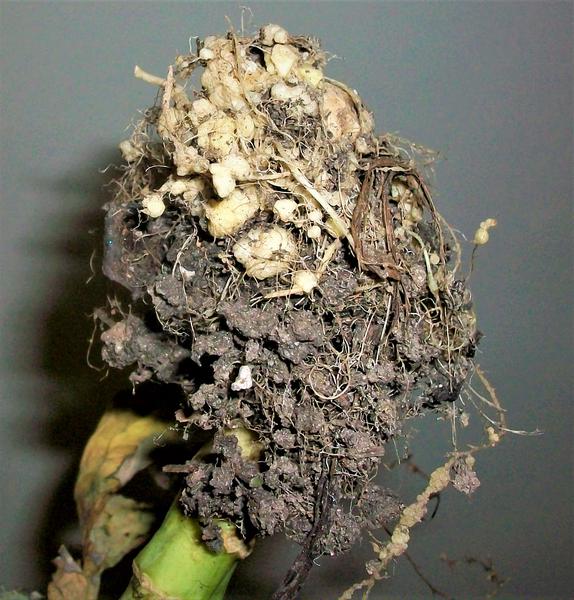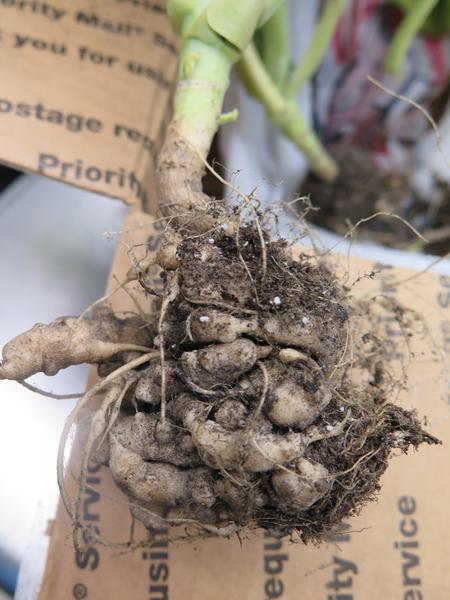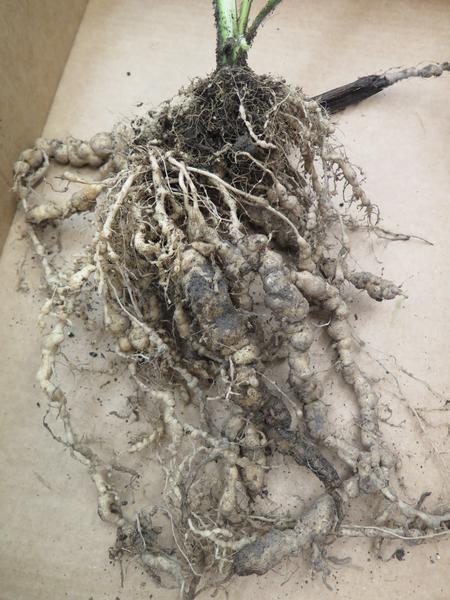Introduction
Clubroot is a disease of crucifer crops (Brassicaceae) that limits production worldwide. It can cause drastic reductions in yield and can be very difficult to manage once introduced to a location.
Pathogen
Clubroot of brassicas is caused by the soil microorganism Plasmodiophora brassicae. This microorganism is an obligate parasite that can only grow and reproduce in living roots. Plasmodiophora brassicae is capable of surviving in the soil for more than 10 years by producing thick-walled, resting spores. Resting spores typically germinate in response to root exudates released from a susceptible host to form swimming spores (zoospores) that can move in water to infect roots. Zoospores infect susceptible plants through root hairs or wounds and form a plasmodium - a wall-less cell with many nuclei. The plasmodium releases more zoospores that cause new root infections. In time, the mature plasmodium is transformed into clusters of resting spores that are eventually released into soil as roots decay. Resting spores can be transported in drainage and irrigation water, infested soil, soil adhering to equipment, tools, and shoes, wind-borne soil particles, and infected transplants.
Plasmodiophora brassicae is found worldwide where brassicas are grown, and is especially prevalent in humid, temperate regions.
Host Plants
The pathogen infects the roots of broccoli, Brussels sprouts, cabbage, Chinese cabbage, cauliflower, collard, kale, kohlrabi, mustard, oilseed rape (canola), radish, rutabaga, and turnip.
The organism can infect cruciferous weeds (mustard family) and root hairs on non-brassica plants, including grasses, such as Agrostis (Bentgrass), Dactylis (Orchard Grass), Holcus (Velvetgrass), and Lolium spp. (Ryegrass), and dicotyledons, such as Fragaria (Wild Strawberry), Papavar (Poppy), Trifolium (red clover), and Rumex spp (Sorrel). Although characteristic clubroot symptoms do not form on these hosts, they should be avoided for use as cover crops in fields with a history of clubroot.
Symptoms and Signs
The most characteristic symptoms are root distortion and galling (swelling). The galling symptoms give roots a 'club-like' appearance. This symptom is a result of the abnormal increase in cell growth and division. Galls are firm and have a white interior at the beginning of infection, and eventually turn brown and decay. The severity of galling can vary based on plant age, root morphology, and length of exposure. For example, newly infected roots have small (1- 20mm) galls on roots, whereas older infections result in long, spindle-shaped clubs.
Infected plants may wilt during the day and recover at night due to the decrease in water and nutrient uptake as a result of the galls. Since growth is directed to the swelling galls, plants grow more slowly, are stunted, may have fewer, smaller leaves, and blue-green foliage. Keep in mind that other soilborne pathogens can cause these symptoms, so it is important to examine the roots for the characteristic swellings. The disease may progress extensively before above-ground symptoms develop.
Symptoms vary between hosts. The infection of fibrous rooted cole (broccoli, cabbage, etc.) and oilseed crops results in a mass of coral-shaped galls (Figure 1), whereas galls on turnips or rutabagas may partially (Figure 2) or completely cover the surface, affecting the taproot and secondary roots.
Lookalike diseases. Infection by root knot nematode (Meloidogyne spp.) also can cause swellings on roots, although brassicas are less likely to be affected by this nematode. The galls formed by root knot nematode are typically smaller and more round in shape than those caused by the clubroot pathogen.
Disease Cycle and Epidemiology
The severity of clubroot is heavily influenced by soil conditions. The pathogen germinates in wet soils when the soil temperature is between 18 and 25 ºC (64 to 77 F), and the soil pH is acidic (pH less than 7.0). Reducing soil moisture and increasing soil calcium and soil pH (pH above 7.0) may limit disease development, but does not completely suppress infection and spread of P. brassicae.
Disease Management for Conventional and Organic Growers
Prevent introduction. Management is focused on preventing the introduction of this pathogen into a field. Once this pathogen is established in a field or location, eradication is improbable, and several management practices must be implemented to reduce levels of inoculum and viability of the pathogen.
Sanitation. Sanitize infested tools and equipment when moving between fields, especially infested fields, to prevent pathogen spread to new locations. Remove all soil from equipment and tools and apply a surface disinfectant or 1% bleach solution. Make sure the areas are wet with solution for 15-20 min.
Use disease-free transplants. Although the pathogen cannot be spread through seed, it can be spread through infected transplants. If transplants within a tray appear unhealthy, it's best to dispose of the entire tray as adjacent seedlings are likely infected, but not showing symptoms yet. When possible, purchase certified transplants.
Crop rotation. Crop rotation may reduce clubroot infestation. Infested fields should be rotated away from brassica for a minimum of 4-7 years, but this is not guaranteed to prevent disease. Spring-grown crops require longer rotations because temperatures during this season are optimal for P. brassicae. Planting corn or alfalfa can reduce the amount of inoculum of P. brassicae. Because weedy hosts (listed above) can allow the pathogen to reproduce, weed management is critical. It is important to combine crop rotation with other disease management strategies.
Green manure. Adding green manure followed by plowing, adding organic soil amendments, and soil solarization (in areas with high solar radiation) are effective means of reducing the level of soil infestation. Soil solarization may not be economical because it is only effective when conducted during the cropping season. Deep-plowing of soil can decrease the amount of inoculum, presumably by causing the resting spores to desiccate.
Increase soil pH. Alkaline soils and soils with high calcium content suppress the potential of the pathogen to initiate infection. Liming to raise soil pH to 7.1-7.5 can slowly reduce disease severity, although this strategy is not completely reliable when there is a well-established infestation. Calcitic lime is recommended over dolomitic lime unless the field has low levels of magnesium.
Reduce soil moisture. The pathogen is adapted to wet environments. Therefore, avoid planting in saturated or very wet fields that are known to be infested with the pathogen. Increasing drainage, deep-plowing, breaking up a hard pan, or planting in raised beds can reduce disease severity.
Resistant varieties. There is a limited selection of vegetable varieties resistant to clubroot. Additionally, strains of the pathogen vary by location, and some strains may overcome host resistance. Regardless, plant resistant varieties whenever possible.
Avoid water run-off. Manage irrigation to avoid run-off from contaminated fields into irrigation ponds.
Eliminate weeds. Eliminate weedy hosts and brassica crop volunteers.
Biopesticides. There are no biopesticides that effectively manage clubroot. Organic growers should follow the above management recommendations.
Fungicide applications. Fungicides have not provided adequate or consistent disease control. Additionally, effective rates are so high that application is often financially impractical. Regardless, options are listed below. Be sure to check the label before application.
|
Product name |
Active Ingredient |
FRAC |
Comments |
|
Blocker |
PCNB (Pentachloronitrobenzene) |
14 |
Apply as a drip application to transplants after transplanting or as a banded application with soil incorporation 4 to 6 in deep prior to planting. |
|
Omega 500F |
fluazinam |
29 |
Apply either to transplants directly after planting as a drench or as a banded application with soil incorporation of 6 to 8 in prior to transplanting. Harvest may be delayed and stunting may occur without loss in yield. |
|
Ranman |
cyazofamid |
21 |
Apply either to transplants directly after planting as a drench or as a banded application. |
Disease Management for Homeowners
Prevent introduction. Avoid introduction of this pathogen into a garden. Once this pathogen is established in a location, eradication is improbable.
Sanitation. Sanitize infested tools and equipment when moving between plots, especially infested plots, to prevent pathogen spread to new locations
Use disease free transplants. Although the pathogen cannot be spread through seed, it can be spread through infected transplants. If a tray of transplants is affected or appears unthrifty, it's best to dispose of the entire tray as adjacent seedlings are likely infected but not yet showing symptoms.
Raised beds. If a garden area becomes infested with the clubroot pathogen, homeowners can construct raised beds. These allow for the use of clean soil and will increase soil drainage, which can help prevent other diseases.
Crop rotation. If raised beds are not an option, crop rotation can be employed to minimize the likelihood of clubroot infestation. Infested plots should be rotated away from brassica for a minimum of 4-7 years. Spring-grown crops require longer rotations because conditions for infection by P. brassicae are optimal during this time. Planting corn or alfalfa can reduce the amount of inoculum of P. brassicae. Because weedy hosts can allow the pathogen to reproduce, weed management is critical.
Bury affected crops. If you find symptomatic plants in your garden, remove them and bury or dispose of them away from your garden.
Reduce soil moisture. The pathogen is adapted to wet environments. Therefore, limiting soil moisture will help to reduce disease.
Resistant varieties. There is a limited selection of clubroot resistant varieties available. Additionally, strains vary by location, and a resistant host in one location may not be resistant in another. Regardless, plant resistant varieties whenever possible.
Avoid water run-off. Manage irrigation to avoid run-off from contaminated plots coming into contact with other plots or a water source.
Eliminate weeds. Eliminate weedy hosts and brassica crop volunteers.
Fungicide applications. There are no effective fungicides for homeowners.
Resources
- The NC State University Plant Disease and Insect Clinic provides diagnostic services and control recommendations
- The NC State Extension Plant Pathology portal provides information on crop disease management
- The Southeastern US Vegetable Crop Handbook provides information on vegetable disease management
Publication date: June 9, 2021
N.C. Cooperative Extension prohibits discrimination and harassment regardless of age, color, disability, family and marital status, gender identity, national origin, political beliefs, race, religion, sex (including pregnancy), sexual orientation and veteran status.
Recommendations for the use of agricultural chemicals are included in this publication as a convenience to the reader. The use of brand names and any mention or listing of commercial products or services in this publication does not imply endorsement by NC State University or N.C. A&T State University nor discrimination against similar products or services not mentioned. Individuals who use agricultural chemicals are responsible for ensuring that the intended use complies with current regulations and conforms to the product label. Be sure to obtain current information about usage regulations and examine a current product label before applying any chemical. For assistance, contact your local N.C. Cooperative Extension county center.
N.C. Cooperative Extension prohibits discrimination and harassment regardless of age, color, disability, family and marital status, gender identity, national origin, political beliefs, race, religion, sex (including pregnancy), sexual orientation and veteran status.




